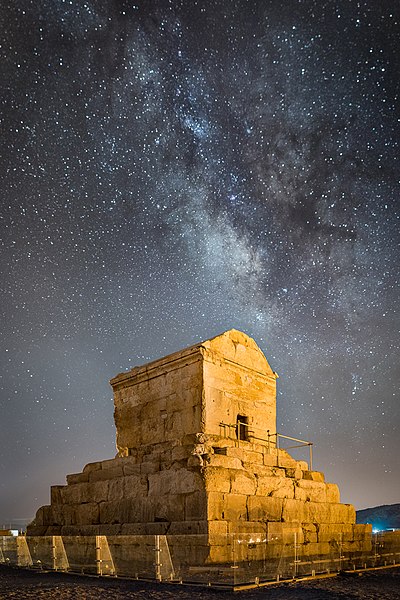User:John Andersson (WMSE)/Test
About the exhibition concept and content[edit]
| Deutsch • English • français • italiano • svenska |
| Islamic Republic of Iran: Pasargadae |
|---|

|
| Pasargadae was the capital of the first great multicultural empire in Western Asia. Spanning the Eastern Mediterranean and Egypt to the Hindus River, it is considered to be the first empire that respected the cultural diversity of its different peoples. Particularly noteworthy vestiges in the 160-ha site include: the Mausoleum of Cyrus II; Tall-e Takht, a fortified terrace; and a royal ensemble of gatehouse, audience hall, residential palace and gardens. This was reflected in Achaemenid architecture, a synthetic representation of different cultures. It was inscribed on World Heritage List in 2004. The site has several risk factors including erosion resulting from various factors (physical, chemical, environmental, etc.); damage that may result from agriculture or from flooding; excavations that put the archaeological remains at increased risk and vandalism.
This text is partly or solely based on the information provided in the article “Pasargadae” on http://whc.unesco.org/en/list/1106, licensed CC BY-SA 3.0. The #Unite4Heritage movement aims to celebrate and safeguard cultural heritage and diversity around the world, calling on everyone to stand up against intolerance and sectarianism by promoting and rejoicing in cultural diversity. Intentional destruction, public negligence, intensive tourism and economic development, ignorance and poor maintenance threaten much of our cultural heritage and diversity. UNESCO, Wikimedia Sverige and Wikimedia Italia decided to join forces to highlight the importance of preserving cultural heritage through photography, so people can be sensitized to protect heritage, preserve cultural identity and build a common future. UNESCO and Wikimedia believe that the valorization of heritage images and making information available to the public will reduce the risk of losing heritage and help people celebrate, better protect and be proud of their cultural diversity. This exhibition showcases the fragility of our common cultural heritage in all its different forms – utilising the freely licensed images that are available. These images have been shared by a variety of sources including museums, archives and the general public on Wikimedia Commons, the media site for Wikipedia. On Wikimedia Commons millions of images are under free license so that everyone has the opportunity to use and adapt them. The collection is maintained and improved by thousands of unpaid volunteers. The public can enter photography competitions related to different kinds of cultural heritage including Wiki Loves Monuments for built cultural heritage, Wiki Loves Africa for African intangible cultural heritage and Wiki Loves Earth for natural heritage. For more information, see tinyurl.com/wikiloves. You can get involved on Wikipedia, Wikimedia Commons and Unite4Heritage. |
About the Connected Open Heritage project[edit]
| Deutsch • English • français • italiano • svenska |
| Afghanistan: Minaret and Archaeological Remains of Jam |
|---|

|
| The 65 meter tall Minaret of Jam is a graceful, soaring structure, dating back to the 12th century. Covered in elaborate brickwork with a blue tile inscription at the top, it is noteworthy for the quality of its architecture and decoration, which represent the culmination of an architectural and artistic tradition in this region. Its impact is heightened by its dramatic setting, a deep river valley between towering mountains in the heart of the Ghur province. The site is inscribed in the List of World Heritage In Danger since 2002. Erosion of the riverbanks adjacent to the Minaret, any further movement in the level of inclination of the monument along with any degradation in the historic fabric of the site in general need to be monitored.
This text is partly or solely based on the information provided in the article “Minaret and Archaeological Remains of Jam” on http://whc.unesco.org/en/list/211, licensed CC BY-SA 3.0. The Connected Open Heritage project aims to gather and connect as much freely licensed information as possible about threatened cultural heritage, through the Wikimedia projects. It is building on the work done by volunteers from all over the world. If people and decision makers can easily find accurate and reliable information about the important cultural heritage they have around them, the likelihood of the heritage being protected will increase. Wikipedia articles will be improved through the addition of official datasets of nationally protected cultural heritage, and with digitized historical images from museum, archives and the general public depicting the heritage. It will be easier than ever to learn more about the world's cultures. The Connected Open Heritage project partners are Wikimedia Sverige, UNESCO, Wikimedia Italia - together with Gruppo Archeologico Romano and association DecArch - and Cultural Heritage without Borders. The project is financed and supported by the Culture Foundation of the Swedish Postcode Lottery. Learn more about the project: tinyurl.com/ConnectedOpenHeritage |
